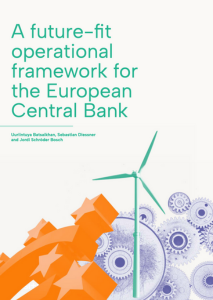A future-fit operational framework for the European Central Bank
The European Central Bank (ECB) has recently revised its operational framework, as have other central banks including the Bank of England and the US Federal Reserve. In this policy paper, we take a deep dive into the ECB’s revision and propose an alternative framework.
The operational framework encompasses the measures and intermediary targets that central banks use to implement their monetary policy stance. These measures include how liquidity is provided, which counterparties are eligible, and the rules on collateral use, among others. The way the ECB sets up its operational framework has far-reaching consequences for its capacity to conduct monetary policy in the coming years, including for the flexibility with which it can use its balance sheet and for its ability to support the green transition.
The ECB’s new operational framework has three main characteristics: (1) the operational target will be steered between the main refinancing operations and the deposit facility rates; (2) banks' aggregate liquidity needs will primarily be met through refinancing operations based on banks’ demand; (3) remaining liquidity needs will be addressed through a diverse range of instruments, including a structural portfolio of securities and longer-term refinancing operations.
This paper assesses the ECB’s revised operational framework and formulates three main critiques: (1) the framework is not robust: its main characteristics are not compatible with monetary policy interventions that increase the ECB’s balance sheet substantially in the future. Hence, it is not an operational framework “for all seasons”; (2) its priorities are misplaced: aiming for a lean balance sheet to spur “market discipline” does not consider how the latter failed before the global financial crisis (GFC) nor how money markets have changed over the last decades; (3) this misplaced prioritisation limits policy space for achieving the ECB’s objectives, including supporting the green transition.
We provide an alternative framework that addresses these critiques. We propose a floor system with an ample and flexible balance sheet. Most of the liquidity provision would be achieved through a securities portfolio and green targeted longer-term refinancing operations, which would be supply-determined by the ECB. It would also apply a flexible remuneration to bank reserves through tiered remuneration so as to avoid undesirable windfall profits. Our alternative framework entails several benefits: promoting stability in sovereign bond markets, enhancing monetary policy transmission, accommodating financial stability interventions, providing more policy space to support the green transition, and enabling robust responses by the ECB to increasingly frequent shocks.

You can download the report below.